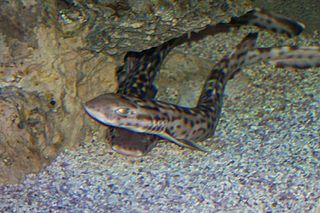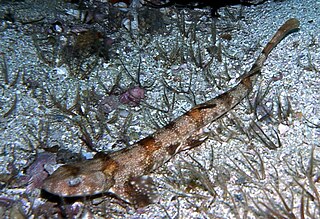
Catsharks are ground sharks of the family Scyliorhinidae. They are the largest family of sharks with around 160 species placed in 17 genera. Although they are generally known as catsharks, some species can also be called dogfish due to previous naming. However, a dogfish may generally be distinguished from a catshark as catsharks lay eggs while dogfish have live young. Like most bottom feeders, catsharks feed on benthic invertebrates and smaller fish. They are not harmful to humans. The family is paraphyletic, containing several distinct lineages that do not form a monophyletic group.

Apristurus is a genus of catsharks, the family Scyliorhinidae, commonly known as the ghost or demon catsharks.
The New Zealand catshark is a catshark of the family Scyliorhinidae in the order Carcharhiniformes. This species is endemic to in the deep waters around New Zealand. Its length is up to 45 centimetres (18 in). The New Zealand catshark is a small, little-known deep water bottom shark. It is dark brown around the top with a few widely spaced pale spots, and white below. It feeds on bottom-living crustaceans. It is also completely harmless to humans.

Parmaturus is a genus of catsharks in the family Scyliorhinidae. Four species were described in 2007 and another in 2019 with more species likely to be described in the near future.

Atelomycterus is a genus of catsharks in the family Scyliorhinidae.
Asymbolus is a genus of catsharks in the family Scyliorhinidae.

Haploblepharus is a genus of catshark, and part of the family Scyliorhinidae, containing four species of shysharks. Their common name comes from a distinctive defensive behavior in which the shark curls into a circle and covers its eyes with its tail. The genus is endemic to southern Africa, inhabiting shallow coastal waters. All four species are small, stout-bodied sharks with broad, flattened heads and rounded snouts. They are characterized by very large nostrils with enlarged, triangular flaps of skin that reach the mouth, and deep grooves between the nostrils and the mouth. Shysharks are bottom-dwelling predators of bony fishes and invertebrates. They are oviparous, with the females laying egg capsules. These harmless sharks are of no commercial or recreational interest, though their highly limited distributions in heavily fished South African waters are of potential conservation concern.

The quagga catshark is a species of catshark, belonging to the family Scyliorhinidae. A small, slim-bodied shark reaching 37 cm (15 in) in length, it has a distinctive color pattern of narrow, dark brown vertical bars, which resemble those of the quagga. Its head is short and flattened, with a pointed snout tip that is not upturned.

The tiger catshark is a species of catshark, belonging to the family Scyliorhinidae. It is found over sandy areas and near reef peripheries off South Africa and perhaps Mozambique, from close to shore to usually no deeper than 100 m (330 ft). Reaching a length of 50 cm (20 in), this small, slim shark has a broad, flattened head with an upturned snout tip. It can additionally be identified by its dorsal colour pattern of ten dark brown saddles on a yellowish brown background.

The lined catshark or banded catshark is a species of catshark, belonging to the family Scyliorhinidae. It is found in the waters off the coasts of Beira, Mozambique, to East London, and South Africa between latitudes 19°S and 31°S, from the surface to 290 m. It can grow up to 56 cm in length.

The blackspotted catshark is a catshark of the family Scyliorhinidae. It is found in the waters off the coasts of Japan, Korea, China, and Taiwan between latitudes 39° N and 20° N, at the depths of between 80 and 100 m. It can grow up to 49 cm in length.

The speckled catshark is a catshark of the family Scyliorhinidae. It is found in the Gulf of Aden and off the coast of Somalia. It occurs at depths of between 37 and 250 m. Its length is up to 48 cm.
Bythaelurus is a genus of deep-water catsharks and part of the family Scyliorhinidae. The genus Bythaelurus Compagno 1988 was first described as a subgenus of Halaelurus Gill 1862 based on several morphological characteristics including a soft body with thin skin, a bluntly rounded snout without a pointed, knob-like tip, and eyes not noticeably elevated on the dorsal surface of the head. Members of this genus are generally found in deep water and have more somber body coloration.
The mud catshark or brown catshark is a species of catshark in the family Scyliorhinidae. It is found in Mozambique and Somalia. Its natural habitat is the open seas of the western Indian Ocean, from Mozambique to Somalia, between latitudes 13° N and 29° S, at depths between 340 and 765 m. It can grow up to 34 centimetres (13 in) long.
The speckled swellshark is a little-known species of catshark, and part of the family Scyliorhinidae, endemic to the waters off northwestern Australia. It occurs on the outer continental shelf and upper continental slope, at a depth of 150–455 m (492–1,493 ft). This species grows to 69 cm (27 in) long and has a stocky body and a short, broad, flattened head. As its common name suggests, its color pattern consists of many dark spots and white-spotted dark saddles and blotches on a light gray background. The juveniles are yellow with dark spots and lines, and a distinctive eyespot-like mark behind each eye. Like other swellsharks, this species can inflate itself as a defensive measure.
The Indonesian speckled catshark is a species of catshark in the genus Halaelurus. It is a tropical catshark found in the Pacific Ocean. It was named by W. T. White, P. R. Last, and J. D. Stevens in 2007. Male Halaelurus maculosus can reach a maximum length of 45.7 centimetres (18.0 in), while females can reach a maximum length of 52.8 centimetres (20.8 in). Catsharks in this species are occasionally caught by demersal fisheries.
The rusty catshark is a species of catshark in the genus Halaelurus. It is a tropical catshark found around the waters off Australia, in the eastern Indian Ocean. It was named by W.T. White, P.R. Last, and J.D. Stevens in 2007. Male Halaelurus sellus can reach a maximum length of 35.3 centimetres, while females can reach a maximum length of 42.3 centimetres.











